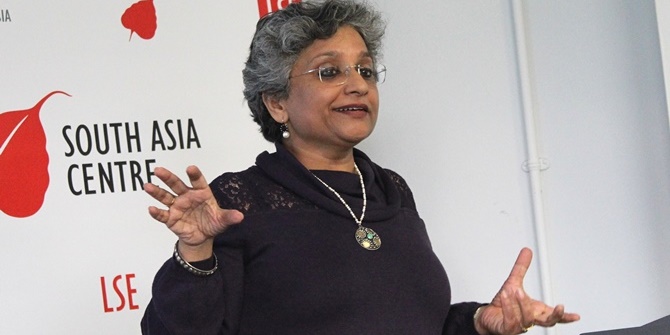
 Privately-funded higher education institutions have been materializing across India in the last few years. Anamika Srivastava & Deepanshu Mohan consider how these new universities challenge the traditional value, nature and goals attached to education. They argue that while private investment is necessary to meet increasing demand, new institutions must be careful not to compromise or contradict the larger social goals of higher education.
Privately-funded higher education institutions have been materializing across India in the last few years. Anamika Srivastava & Deepanshu Mohan consider how these new universities challenge the traditional value, nature and goals attached to education. They argue that while private investment is necessary to meet increasing demand, new institutions must be careful not to compromise or contradict the larger social goals of higher education.
The ray of optimism in a new ‘Shining’ India under the Modi-led government seems to be primarily focusing on improving access to higher education and recuperating the process of skill development pan India. In recent months there has trend of massive proliferation in the number of new private universities in India as leading corporate honchos like the Ambanis, Baba Kalyani, Munjals, Azim Premji etc. have joined pre-existing ‘edupreneurs’ with proposals for starting new universities.
There is no doubt that a severe infrastructural crunch within the higher education sector in India has been responsible for this paradigm shift. Right from the Ambani Birla report, 2000 to the Narayana Murthy Committee report, 2012 there has been a loud call for relaxing the regulatory environment paving way for corporate sector participation. Until recently, only a dismal 10% of India’s young people were going into higher education (compared to 50% in developed nations). As this changes, the sector needs to adapt to respond to the increasing demand.
The rationale here is to not vilify the upswing in the number of edupreneurs across the country but examine it in context of the rapidly transforming value, nature and goals attached to education, particularly when viewed through the lens of economics. This tryst of economics with education goes back to the writings of classical economists like Adam Smith (1776), David Chadwick (1862) and Alfred Marshall (1890). While the classical economists acknowledged the linkages between education and productivity, it was only in 1960s through the work of Mincer (1958) and Schultz (1960, 1962); and later Becker (1975), the formal economic theory conceptualising expenditure on education as investment, popularly known as the human capital theory, was laid out.
In India, the 1960s saw a substantial increase in the government expenditure on education. In the Nehruvian era of a welfare ensuring socialist government, higher education was primarily considered a state responsibility echoing the dominant line in economics of education of this era. Education and growth linkages were reinforced later in the work of Romer (1986, 1992) and Lucas (1988), with the emphasis once again on the public good character of ‘human capital’, where the output of a given firm depends not only on the measure of human capital actually used in the firm but also on the average level of human capital in the economy as a whole. This again hinted towards the role of the government.
The recent policy discourse on higher education in India is clearly inclined for a greater role of private sector both in terms of provisioning as well as funding. If we look at the numbers, technically speaking, most of the recently started private universities can be identified as State Private Universities (SPUs) as they’ve been established under the state private university acts. Total universities in India increased from 621 in 2011 to 642 in 2012. Out of these 21 new universities, 18 were SPUs. There has been a drastic increase is in the SPUs in the last five years from 42 in 2009 to 187 in 2014. As per a latest estimate, 27.4 % of university education is now provided by private universities.
Most universities are set up as not-for-profit ventures under Section 25 of the 1956 Companies Act and existing traditional private universities as well as public institutions are under growing pressure to reform themselves in accordance with market principles. However, with the rise in new private players, an open market in higher education has emerged. This is justified on the grounds that, in the absence of government funds, market forces in a competitive environment compels the suppliers to cater to the preferences of the consumers and lead to efficient outcome(s).
Yet market logic cannot be simply applied to education. Why not? It is difficult to theorise the commodity/service of ‘higher education’ in economics because it is a ‘quasi-public good’ i.e. it is a private good accruing private benefits with positive externalities accruing to the society at large. A move towards market would lead to enhancing the private character at the expense of the public character of higher education. Further, input-output relationship cannot be defined in the case of education which is more of a ‘process’ than product.

Not all private institutions are established for business and thus should not be discounted. Gordon C. Winston has noted that the higher in India is stratified into various bands, where institutions within each band are competing amongst themselves on the basis of different criteria. When it comes to those at the top of the hierarchy of Indian institutions, it is observed that they tend to behave in a similar way regardless of whether they are public or private. First rate private institutions can be seen across India – for example, Indian Institute of Science (IISC), Bangalore; Tata Institute of Fundamental Research (TIFR), Mumbai; and Birla Institute of Technology & Science (BITS), Pilani (to name but a few).
However, the newer private universities do seem to be different in the mode of funding, mission, nature. The Indian constitution lucidly designates education as not-for-profit business, and thus, it would be interesting to probe the motivations behind the establishment of new private universities.
In the last decade or so, the debate in the international arena on higher education quality has increasingly shifted from quality to ‘excellence’. In fact, ‘excellence’ has become a buzz word amongst these emerging higher education institutes. Their quest for ‘excellence’ may translate into a quest for ‘prestige maximisation’ which can have worrying implications for the larger social goal of higher education. For instance, in the process of ‘prestige maximisation’ these institutions may become highly selective challenging notions of accessibility and equity in higher education. At the same time, it is also apprehended that many of these emerging educational institutions are here to siphon off profits without recording it.
Jamil Salmi rightly argues that the governance framework and the availability of financial resources are the most essential characteristics of quality higher education as they entail autonomy of research universities. These characteristics are further translated into ability to recruit and retain the best talent in terms faculty and students and provisioning of the best of infrastructure for teaching and learning; and research.
It is therefore to be argued that new private universities cannot simply emulate the mission, nature and the ways of the ‘prestigious universities’ due to inherent nature of the education sector. Education is a process rather than just a vector of tangible products whose production can be replicated by replicating the inputs. The culture, ethos, mission of a ‘prestigious institutions’ are developed over a period of time and is specific to the institution, its local as well as global context. Autonomy of an institution is an intrinsic feature of a prestigious university which is associated with the mode of funding. Lack of public funding can never be used as an excuse of ‘commodifying’ the imparting of education.
To remain within the non-profit framework, private universities need to generate enough revenues to sustain themselves. Exploring various avenues for revenue generation such as private donors and sponsors, industry linkages, entering into related/unrelated business practices, all are valid as long as the larger social goals of higher education are not compromised and contradicted.
About the Authors
 Anamika Srivastava is Assistant Professor and Assistant Director, Centre for Social and Education Policy at the Jindal Global Law School
Anamika Srivastava is Assistant Professor and Assistant Director, Centre for Social and Education Policy at the Jindal Global Law School
 Deepanshu Mohan is a regular columnist for India At LSE and Senior Research Associate at the Jindal School of International Affairs, O.P. Jindal Global University, India. He graduated from LSE with an MSc. in Economic History in 2012. Read more of his posts here.
Deepanshu Mohan is a regular columnist for India At LSE and Senior Research Associate at the Jindal School of International Affairs, O.P. Jindal Global University, India. He graduated from LSE with an MSc. in Economic History in 2012. Read more of his posts here.








What I observe in the Indian scene of private higher education is not much of a claim of adhering to or advancing higher human Values but claims of “connection” with foreign (not based in India) universities and in-campus “recruitment percentages”. Attractive photographs of campus and students and high-octane marketing presentations dominate the advertisements of the proliferating private Investment activities in the field of education in India. One gets the impression of not merely profit-making but profiteering.
R.Venkatanarayanan